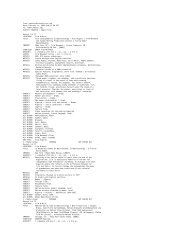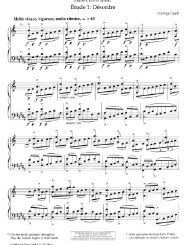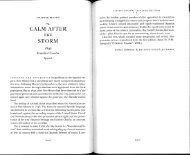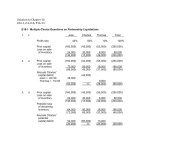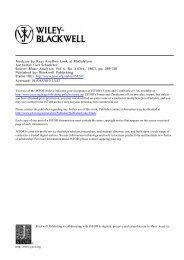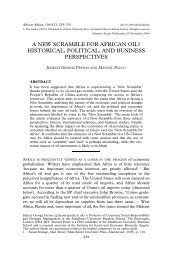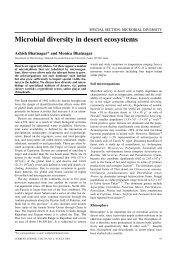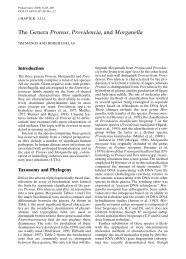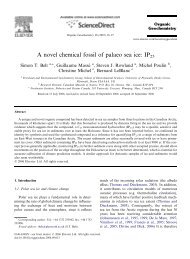The Genus Serratia
The Genus Serratia
The Genus Serratia
Create successful ePaper yourself
Turn your PDF publications into a flip-book with our unique Google optimized e-Paper software.
236 F. Grimont and P.A.D. Grimont CHAPTER 3.3.11<br />
Table 10. Correlation between biogroups and serotypes in <strong>Serratia</strong> marcescens.<br />
Biogroup a Serotypes included<br />
A1 O5:H2; O5:H3; O5:H13; O5:H23; O10:H6; and O10:H13<br />
A2/6 O5:H23; O6,14:H2; O6,14:H3; O6,14:H8; O6,14:H9; O6,14:H10; O6,14:H13; O8:H3; and O13:H5<br />
A3 O3:H5; O3:H11; O4:H5; O4:H18; O5:H6; O5:H15; O6,14:H5; O6,14:H6; O6,14:H16; O6,14:H20; O9:H9;<br />
O9:H11; O9:H15; O9:H17; O12:H5; O12:H9; O12:H10; O12:H11; O12:H15; O12:H16; O12:H17; O12:H18;<br />
O12:H20; O12:H26; O13:H11; O13:H17; O15:H3; O15:H5; O15:H8; O15:H9; O17:H4; O18:H21; O18:H26;<br />
O22:H11; and O23:H19<br />
A4 O1:H1; O1:H4; O2:H1; O2:H8; O3:H1; O4:H1; O4:H4; O5:H1; O5:H6; O5:H8; O5:H24; O9:H1; O13:H1;<br />
O13:H11; and O13:H13<br />
A5/8 O2:H4; O3:H12; O3,21:H12; O4:H12; O5:H4; O6,14:H4; O6,14:H12; O8:H4; O8:H12; O15:H12; and O21:H12<br />
TCT O1:H7; O2:H7; O4:H7; O5:H7; O5:H19; O7:H7; O7:H23; O10:H8; O10:H9; O11:H4; O13:H7; O13:H12;<br />
O16:H19; O18:H9; O18:H16; O18:H19; O19:H14; O19:H19; O20:H12; and O24:H6<br />
a Biogroup A1 is composed of biotypes A1a and A1b; A2/6 is composed of A2a, A2b, and A6; A3 of A3a, A3b, A3c, and A3d;<br />
A4 of A4a and A4b; A5/8 of A5, A8a, A8b, and A8c; and TCT of TCT and TT.<br />
used to achieve final identification of H antigens.<br />
<strong>The</strong> following absorbed sera need to be prepared:<br />
anti-H:8 absorbed by H:10; anti-H:10<br />
absorbed by H:8; and anti-H:3 absorbed by H:10.<br />
Other cross-reactions are overcome by dilution<br />
of sera. <strong>The</strong> immobilization test works because<br />
H antigens are monophasic in S. marcescens.<br />
A total of 175 complete (O+H) serotypes have<br />
been identified at this time. No plasmid or phage<br />
has yet been found to alter the serotype of a<br />
strain.<br />
Some striking correlations between antigenic<br />
composition and biotype have been shown (Grimont<br />
et al., 1979a). Pigmented biotypes and nonpigmented<br />
biotypes are antigenically segregated.<br />
Serotyping subdivides the biotypes, but when<br />
two biotypes correspond to the same serotype,<br />
these biotypes usually differ by only one biochemical<br />
reaction. Biotypes can be united into<br />
“biogroups” in order to clarify biotype-serotype<br />
correlation (Table 10). <strong>The</strong>se biogroups may be<br />
valid infraspecific taxons.<br />
Serotyping of Other Species<br />
An antigenic scheme for S. ficaria is presently<br />
available (Grimont and Deval, 1982). Four<br />
somatic (O) and one flagellar (H) antigens were<br />
identified that defined four serovars. All American<br />
strains studied (isolated from the fig wasp or<br />
from a human patient) belonged to serotype<br />
O1:H1; strains from the Mediterranean region<br />
(Sicily, Tunisia, France) were not so antigenically<br />
uniform and all four serotypes were found in figs<br />
from Sicily.<br />
An antigenic scheme for S. rubidaea has also<br />
been devised (Grimont et al., manuscript in<br />
preparation). Nine somatic and five flagellar<br />
antigens were identified. A total of 53 strains<br />
were distributed among 14 complete (O+H)<br />
serotypes.<br />
Bacteriocin Typing of <strong>Serratia</strong> marcescens<br />
Two different schemes have been developed for<br />
typing <strong>Serratia</strong> marcescens strains by susceptibility<br />
to bacteriocins (“marcescins”). <strong>The</strong> system of<br />
Traub (1980) was developed since 1971 (Traub et<br />
al., 1971) and uses marcescins (incomplete phage<br />
structures) produced by 10 selected strains. In<br />
1980, 73 bacteriocin types had been described<br />
and about 93% of strains were typable (Traub,<br />
1980). In this system, bacteriocin type 18 is often<br />
associated with serotype 06/14:H12 in multipledrug-resistant<br />
nosocomial strains.<br />
Farmer (1972b) independently developed<br />
another system of typing based on susceptibility<br />
to marcescins. After mitomycin induction, 12<br />
bacteriocin-producing strains were selected, and<br />
the 12 marcescins could subdivide 93 strains into<br />
79 types.<br />
Typing of S. marcescens by production of bacteriocin<br />
was also developed by Farmer (1972a).<br />
Twenty-three strains susceptible to bacteriocins<br />
were selected to serve as indicator strains. Each<br />
unknown S. marcescens strain is treated with<br />
mitomycin, and the marcescin produced (if any)<br />
is identified according to the pattern of susceptibility<br />
demonstrated by indicator strains. This<br />
method could be used to type 91% of the strains<br />
studied.<br />
Phage Typing of <strong>Serratia</strong><br />
Farmer (1975) has developed a phage typing system<br />
common to <strong>Serratia</strong> marscens, S. liquefaciens,<br />
and S. rubidaea (marinorubra). With 74<br />
phages, 95% of the S. marcescens strains and<br />
50% of the S. liquefaciens and S. rubidaea strains<br />
could be typed. Phage typing was found to be<br />
convenient for subdividing prevalent serotypes<br />
(Negut et al., 1975). F. Grimont (1977) independently<br />
developed another phage typing system



